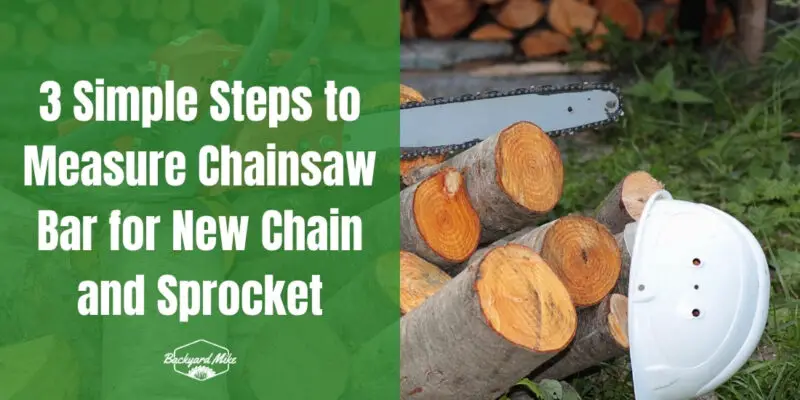To measure your chainsaw bar for a new chain and sprocket, first remove the bar from the saw. With a tape measure, determine the effective cutting length, measuring from the tip to where it connects with the body, excluding any hardware. Next, identify the chain's pitch, gauge, and drive links for proper fit and efficiency. Finally, verify the new parts' compatibility by consulting your chainsaw's specifications or manufacturer guidelines. Following these steps carefully leads to ideal chainsaw performance.
Key Takeaways
- Measure the bar from tip to the body, excluding any hardware, and round to the nearest standard length.
- Determine the chain pitch by measuring the distance between three rivets, then divide by two.
- Verify the chain gauge matches the bar groove width to prevent derailment issues.
- Count the number of drive links to ensure the chain fits the bar correctly.
- Check manufacturer specifications for compatibility between the bar, chain, and sprocket.
Measure the Effective Cutting Length of the Bar
To measure the effective cutting length of your chainsaw bar, start by removing the bar and chain from the saw. This step guarantees bar maintenance by allowing you to achieve measurement accuracy. Use a tape measure or ruler to measure from the tip of the bar to where it meets the chainsaw body, excluding any mounting hardware. This accurate measurement is essential for peak performance and safety, preventing premature wear on the bar and chain. Verify you round your measurement to the nearest standard bar length, like 14", 16", or 18". By doing this, you'll confirm compatibility with chains and sprockets, enhancing your chainsaw's efficiency and safety. When selecting a chainsaw, it's vital to consider safety features like trigger locks and anti-vibration systems to prevent accidents during use. Engine size impacts the ability to cut larger logs; smaller bars are typically paired with smaller engines for optimal performance.
Determine the Chain Specifications
When determining the chain specifications for your chainsaw, it's essential to focus on four key factors: chain pitch, gauge, drive links, and cutter material.
Start by understanding chain pitch, which affects cutting efficiency and compatibility. Common pitches like 3/8 Low Profile or .325″ should match your bar and sprocket. Measure the pitch by dividing the distance between three rivets by two. Determine pitch by checking the marking on the bar, drive link, or cutting tooth of the chain, as well as the rim of the sprocket or the chainsaw manual. Selecting a chain with low kickback options is crucial to ensure user safety, especially when dealing with hardwood.
Determine chain pitch by halving the distance between three rivets; match with bar and sprocket for efficiency.
Next, check the chain gauge; it must match the bar's groove width to prevent derailment. Look for markings on the chain or user manual for guidance.
Count the drive links carefully, as they determine the chain's fit.
Finally, choose a cutter material and style that suits your cutting tasks, ensuring durability and efficiency.
Verify Compatibility and Purchase Replacement Parts
Before purchasing replacement parts for your chainsaw, it's essential to verify compatibility to confirm peak performance and safety. Start by confirming the bar types that match your chainsaw, focusing on length, pitch, and gauge. Check the manufacturer specifications for your specific model to ascertain accurate compatibility. A mismatched bar can lead to poor performance or even damage. Chainsaw bars must match specific dimensions and characteristics for optimal operation, ensuring that the chainsaw efficiency is maintained during use. Gas-powered chainsaws, like the Husqvarna 455 Rancher, are known for their power and torque, which makes selecting the right bar even more crucial to maintain their performance. Use a tape measure to determine the bar length, rounding to the nearest even inch. Consult compatibility lists from manufacturers, which can simplify selecting the right parts. Look for ANSI-compliant parts to meet safety standards. Consider reaching out to local dealers or online resources for additional guidance. By confirming compatibility, you'll maintain your chainsaw's efficiency and join the community of knowledgeable chainsaw users.
Frequently Asked Questions
How Do I Safely Clean the Chainsaw Bar Before Measuring?
Start by wearing gloves and safety glasses for safe handling. Use bar cleaning techniques like scraping debris, blowing with an air compressor, and drying. Remember, you're part of a community that values safety and precision.
What Tools Are Necessary for Measuring a Chainsaw Bar and Chain?
You'll need measuring tools like calipers and a ruler for accuracy. Chainsaw accessories such as safety gloves and a stable work surface guarantee safe handling. Together, they make you part of a knowledgeable, safety-conscious community.
How Do I Find the Chainsaw Bar Length in the Owner's Manual?
To find the chainsaw bar length in the owner's manual, check the manual specifications section. You'll see the length measurement usually listed in inches. This guarantees you're part of a community that values safety and precision.
What Are the Safety Precautions When Measuring a Chainsaw Bar?
When measuring a chainsaw bar, wear safety gear like gloves and eye protection. Confirm proper chainsaw handling by checking controls and securing a safe, clear workspace. You're part of a community that values safety and precision.
How Do I Identify Worn-Off Bar Markings for Chain Size?
You're wondering about those worn-off bar markings, right? Use bar identification techniques like a strong light or cleaning. It'll reveal chain compatibility issues you might face. Immerse yourself, and you'll guarantee your chainsaw feels like home!
Conclusion
By following these steps, you'll guarantee your chainsaw is ready for action. Measuring the effective cutting length, determining chain specifications, and verifying compatibility might seem like a coincidence, but they're essential for your chainsaw's performance. Remember, accuracy in these steps prevents future issues, saving you time and effort. With the right measurements, you can confidently purchase replacement parts, guaranteeing your chainsaw runs smoothly. Now, you're set to tackle any cutting task with ease.


